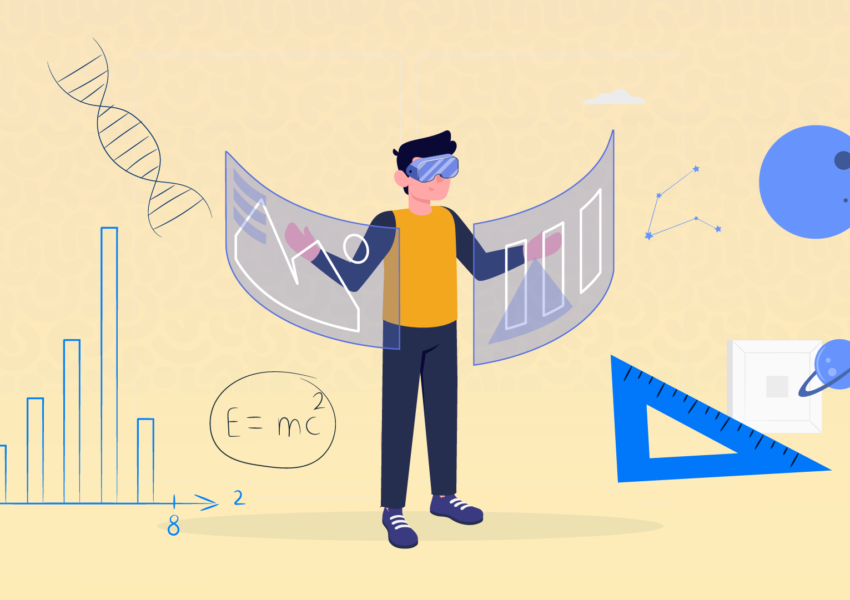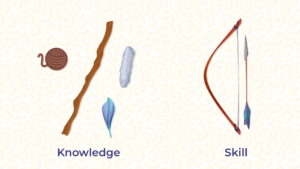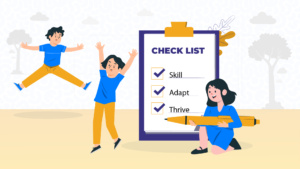
As hunters and gatherers, humans need skills to survive in the wilderness & as tech-savvy individuals, we need skills to thrive. Skills have always been the most effective tool in our arsenal to do day-to-day things and to achieve unbelievable feats. But, the necessary skills themselves have evolved & so have the methods of acquiring them.
With NEP 2020 setting a theme for what 21st-century learning should look like. Here are some quintessential non-negotiables to keep in mind:
Technology baked-in to learning tools
Technology can make skilling accessible, inclusive, interactive & easy. The possibilities are endless. For instance, an AR/VR-enabled classroom can reduce the dependency on student’s imagination alone. A 3D printer can make prototyping ideas accessible to everyone. With interactive learning included within the course, all passive screen time is converted into active screen time.
Gamification
Gamification could come in many forms – interactive learning elements, rewards and coins, locked levels, etc. In all its avatars, different studies have found a significant improvement in
Retention
A study by the Federation of American Scientists found that students recalled 20% of what they heard. When visuals accompanied an oral lecture, the number rose to 30%. If someone took an action along with the explanation, the number rose to 50%. However, if the students perform the job themselves with the use of gamification, they can retain 90% of what they learned.
Motivation
A survey was conducted among 124 students to measure their behaviour and perception of a gamified course as it related to their motivation and engagement levels. It was found that 67.7% of students felt that the gamified course was more motivating than a traditional course.
Performance
A study was conducted among 365 students at the School of Electrical and Computer Engineering of the National Technical University of Athens, Greece. It was found that challenge-based gamification can improve student performance by 89.45% compared to lecture-based education.
Completion rates
300% higher homework completion rate when using a gamified course with levels, badges, and a feedback system.
Classes aligned to children’s attention span
The below data is the average attention spans by age group:
9–10 years old: 20-30 minutes
11-12 years old: 25-35 minutes
13-15 years old: 30-40 minutes
16+ years old: 32-50+ minutes
With that data at hand, it may be unfair to expect a child to sit through hours of lectures & absorb everything that is being taught.
This is where micro-learning makes more sense. Every class is designed to be agile & consensus, usually limited to 10 mins. Students can then take these learnings and apply them to hands-on activities. By doing so student is not bombarded with information they cannot absorb & it ensures that all new learning is applied to the real world.
Offer diverse courses
Exposure to as many courses early on gives students an edge to navigate the uncertainties of the future & also helps them find out their interests.
Be accessible to all
Skill education in the 21st century has to be accessible to all immaterial of the demography or monetary status. It is time that learning becomes an even playing for everyone. With technology & strategic partnerships, it is possible to achieve this goal.
Designed and delivered by Subject Matter Experts
It is essential that everyone gets access to the best mentors. It is unfair that a privileged few get access to the very best. The best of learning can be delivered at scale to any part of the world.
Age-appropriate & safe
Any learning that reaches the hands of a student has to be age-appropriate and moderated. Any student interaction online should be safe from bullying or cyber crimes.
Individualised
Leveraging technology & AI advancements, learning can be personalised to an individual’s needs, abilities & challenges. Feedback & reports too can use data to analyse & give students actionable insights to improve themselves.
Be holistic
Skill learning should be inclusive (for all learning disabilities, preferences, etc;) & should include a mix of both new-age skills (like AI, Coding, Space Technology, Data Science, etc;) & core skills (like Communication, Etiquette, Life Skills, etc;).
Include the community
It’s time that we utilize the wealth of knowledge & skill that the community holds to further expand students’ reach & broaden their horizons.
Skills need to be in line with real-world needs/trends
There has been a seismic shift in hiring patterns and career aspirations in recent years. Gone are the days when traditional degrees held exclusive tickets to success. Today, the landscape is evolving, ushering in an era where skills precede conventional qualifications. This shift is not by chance but is, in part, a response to the changing dynamics of the job market. Employers now seek candidates with practical, hands-on skills that directly translate to workplace success.
The same was, is, and always will be true for those with an entrepreneurial spirit. Having multiple skills & the willingness to acquire more as they progress has always been one of the traits of any entrepreneur.
It is crucial to recognize that any acquired knowledge, be it traditional or technological, holds little value without the corresponding skills to effectively put that knowledge into action.
Knowledge is factual information (comes through education); skill is the ability to apply it (comes through practice).

But how many skills does one need to learn, and how does one pick them? The answer lies in a strategic approach. Instead of chasing every trending skill, individuals should focus on a combination that aligns with their career goals and interests. It’s about quality over quantity, mastering a few select skills that will set one apart in their chosen field.

The mantra in this brave new world is simple: Skill, adapt, and thrive.